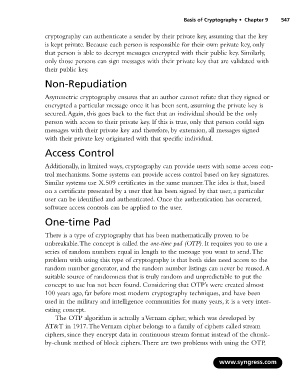Page 563 - StudyBook.pdf
P. 563
Basis of Cryptography • Chapter 9 547
cryptography can authenticate a sender by their private key, assuming that the key
is kept private. Because each person is responsible for their own private key, only
that person is able to decrypt messages encrypted with their public key. Similarly,
only those persons can sign messages with their private key that are validated with
their public key.
Non-Repudiation
Asymmetric cryptography ensures that an author cannot refute that they signed or
encrypted a particular message once it has been sent, assuming the private key is
secured.Again, this goes back to the fact that an individual should be the only
person with access to their private key. If this is true, only that person could sign
messages with their private key and therefore, by extension, all messages signed
with their private key originated with that specific individual.
Access Control
Additionally, in limited ways, cryptography can provide users with some access con-
trol mechanisms. Some systems can provide access control based on key signatures.
Similar systems use X.509 certificates in the same manner.The idea is that, based
on a certificate presented by a user that has been signed by that user, a particular
user can be identified and authenticated. Once the authentication has occurred,
software access controls can be applied to the user.
One-time Pad
There is a type of cryptography that has been mathematically proven to be
unbreakable.The concept is called the one-time pad (OTP). It requires you to use a
series of random numbers equal in length to the message you want to send.The
problem with using this type of cryptography is that both sides need access to the
random number generator, and the random number listings can never be reused.A
suitable source of randomness that is truly random and unpredictable to put the
concept to use has not been found. Considering that OTP’s were created almost
100 years ago, far before most modern cryptography techniques, and have been
used in the military and intelligence communities for many years, it is a very inter-
esting concept.
The OTP algorithm is actually a Vernam cipher, which was developed by
AT&T in 1917.The Vernam cipher belongs to a family of ciphers called stream
ciphers, since they encrypt data in continuous stream format instead of the chunk-
by-chunk method of block ciphers.There are two problems with using the OTP,
www.syngress.com

